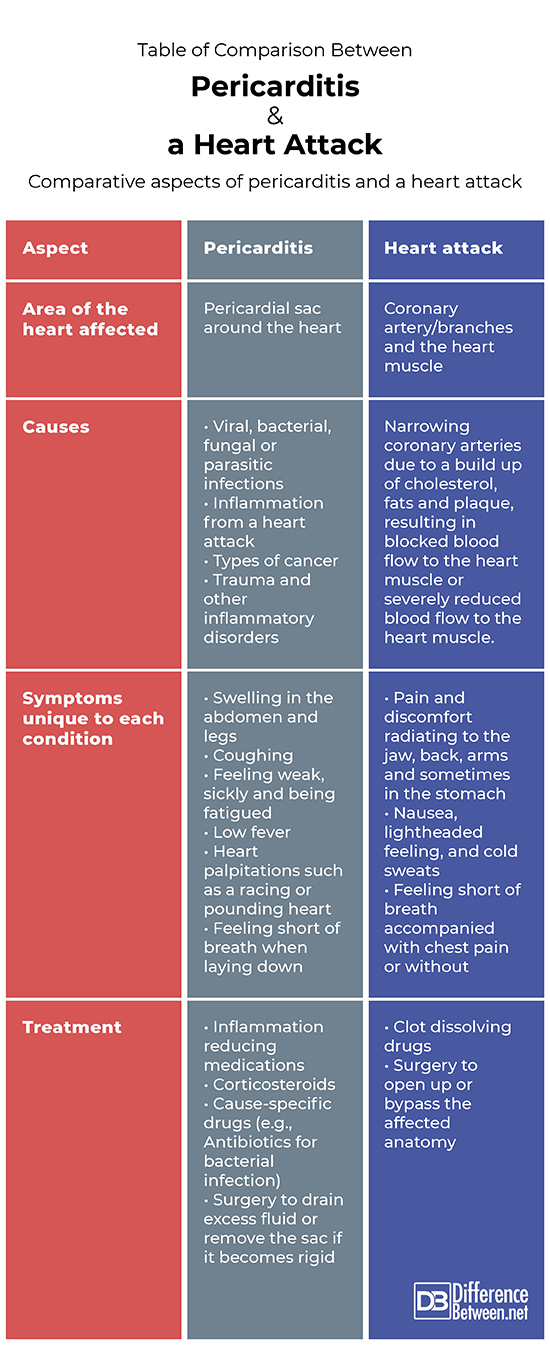Difference Between Pericarditis and Heart Attack
Two conditions of the heart that are often interlinked are pericarditis and myocardial infarction, better known as a heart attack. A heart attack and pericarditis can be interlinked or occur independently of each other, dependant on the scenario and cause behind each condition.

What is pericarditis?
Definition
The pericardium is the membrane that surrounds the heart muscle. When this membrane becomes inflamed, it is in a condition referred to as pericarditis. There are various causes of pericarditis, and these include viral or bacterial infection, parasites or fungi, types of cancer, and any other types of inflammation such as that caused by a heart attack (also referred to as myocardial infarction).
Symptoms
Symptoms experienced by patients vary but are most commonly:
- Chest pain: behind the sternum, worsening when coughing and laying down
- Swelling in the abdomen and legs
- Coughing
- Feeling weak, sickly and being fatigued
- Low fever
- Heart palpitations such as a racing or pounding heart
- Feeling short of breath when laying down
Diagnosis
Pericarditis can be diagnosed through the use of an EKG (electrocardiogram) machine. An EKG machine requires skin sensors, or electrodes, to be placed on the 12 areas of the body. Six placed on the limbs and six placed along the chest area. These electrodes provide electrical views of the heart at different angles, thus presenting a full view in combination. This full view is presented as an EKG reading that is printed on specialized paper to measure rhythm, rate, axis of the heart, hypertrophy and detect infarction.
On an EKG reading, pericarditis appears as an elevated ST segment which sags downwards, and it elevates the T waves off its normal baseline.
Other tests such as blood tests for cardiac markers are often performed.

What is a heart attack?
Definition
A heart attack, also defined as myocardial infarction, occurs when there is a complete blockage of a coronary artery in the heart. The completely occluded artery causes an area of the heart muscle (myocardium) to become deprived of oxygen (infarcted) and that area becomes dead. When the are becomes dead, or necrotic, it is unable to contract and so that area in the heart stops working.
Symptoms
The general symptoms of a heart attack are as follows:
- Discomfort in the centre of the chest, a feeling of chest pressure, a squeezing sensation and chest pain
- Pain and discomfort radiating to the jaw, back, arms and sometimes in the stomach
- Nausea, lightheaded feeling, and cold sweats
- Feeling short of breath accompanied with chest pain or without
Diagnosis
Just as for pericarditis, myocardial infarction can be diagnosed through the use of an EKG machine.
During a heart attack there are changes seen on an EKG reading. The EKG will also show which coronary artery or branch is occluded, narrowed, and where there is a lowering of blood supply to the heart. When there is a reduction in blood supply during a heart attack, the EKG will show an inverted T wave on the reading. When there is injury to the heart muscle present there is ST elevation on the EKG reading. If the heart attack has already resulted in necrosis, or dead heart muscle, then significant Q waves appear on the EKG reading.
Other tests such as x-rays and scans are also performed.
Table of comparison between pericarditis and a heart attack

Summary
Although pericarditis and a heart attack are cardiac conditions with overlapping symptoms, each condition has unique attributes and can be independently diagnosed. Pericarditis is an inflammatory condition of the pericardium around the heart which can occur independently or as a complication of a heart attack, where a heart attack is a condition involving restricted or occluded blood flow to the heart.
FAQ
Is pericarditis a heart attack?
Pericarditis is the inflammation of the membrane which surrounds the heart. It is not a heart attack but can occur as a complication of one.
How can you tell the difference between pericarditis and myocardial infarction (MI)?
Although pericarditis and myocardial infarction appear the same on an EKG test, there is one electrode on the EKG which will differentiate the two. Additionally, there are certain symptoms which are specific to either one of the two conditions, for example, limb swelling is seen in patients with pericarditis.
Does pericarditis increase the risk of a heart attack?
Pericarditis does not necessarily increase the risk of a heart attack but can be a complication after having a heart attack. Pericarditis can increase the risk for other heart complications relating to the sac around the heart, such as cardiac tamponade.
What can pericarditis be mistaken for?
Owing to the fact that pericarditis and a heart attack (myocardial infarction) can both present ST segment elevation on an EKG reading, pericarditis may be mistaken for a heart attack. In addition to this, the symptoms felt for both conditions overlap and are often very similar.
- Difference Between a Cochlear Implant and Normal Hearing - October 4, 2022
- Difference Between Obstructive and Restrictive Spirometry - September 11, 2022
- The Difference Between White Box and Black Box Testing - September 11, 2022
Search DifferenceBetween.net :
Leave a Response
References :
[0]American Heart Association. Heart Attack. https://www.heart.org/en/health-topics/heart-attack
[1]Bischof, Johanna., Worrall, Christine., Thompson, Peter., Marti, David and Smith, Stephan. “ST depression in lead aVL differentiates inferior ST-elevation myocardial infarction from pericarditis”. American Journal of Emergency Medicine, vol. 34, 2016, pp. 149-154
[2]Dublin, Dale. Rapid Interpretation of EKG’s. COVER Inc, 2000, p.7-308
[3]Imazio, Massimo and Gaita, Fiorenzo. “Diagnosis and treatment of pericarditis”. Heart, no. 101, pp. 1159-1168
